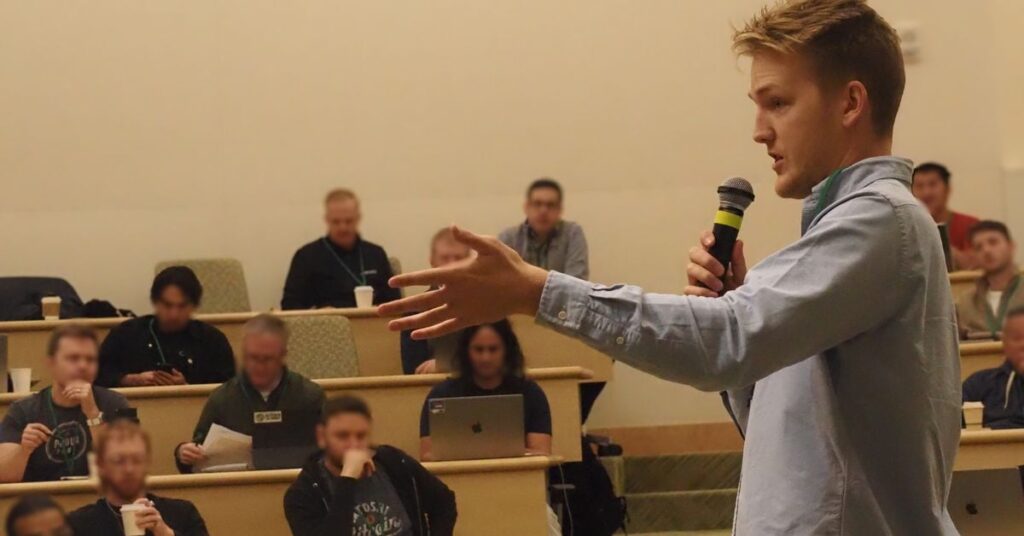BOSTON –– Most of the world focuses on bitcoin (BTC)’s zipping price. Not so for the 100-odd bitcoiners who gathered at Fidelity Investments’ headquarters over the weekend.
They were preoccupied with helping the original cryptocurrency conquer the world – and meantime avoid getting wrecked.
“This is about getting bitcoin to the next billion people,” said Will Foxley, emcee of OP_NEXT, what he claimed was the first bitcoin scaling conference in five years.
OP_NEXT is the newest anomaly on crypto’s overstuffed conference circuit. It’s got none of the retail-friendly bravado of Bitcoin Nashville. It lacks the corporate booths that dot ETH Denver. Few of its speakers shilled their crypto-business ventures, as nearly everyone did at Solana’s rebooted Breakpoint.
Instead, dozens of hoodie-wearing coder boys (and a handful of women) debated improvements that might make bitcoin more useful, usable, and even resilient against faraway problems that could one day upend the world’s most valuable cryptocurrency.
“Either we aggressively pursue innovation and progress as quickly as possible or we will eventually be replaced,” said Paul Sztorc of bitcoin developer company Layer2 Labs.
Bitcoin famously lacks a singular decision-making authority. Proposed upgrades need to find consensus among the community’s many stakeholders, and eventually adoption by the miners who run the computers that run the blockchain. No one quite knows how to know when consensus is reached.
“I know it when I see it,” quipped Colin Harper, the conference host as Blockspace Media’s editor-in-chief (he and Foxley are former CoinDesk reporters).
Soft forks
The two most recent soft forks, or backward-compatible upgrades, helped bitcoin move beyond simply shifting “digital gold” between wallets. Nowadays, network transactions are filled with primitive versions of the wacky crypto-financial wizardry pioneered on Ethereum and other smart contract-centric blockchains. Future soft forks could give this kind of innovation a boost.
While many developers regularly propose upgrades, none have succeeded since Taproot was activated in 2021, and Segwit in 2017 before it. Ossification is starting to set in to Bitcoin Core (the basic open-source software for wallets and nodes), some attendees said. Can bitcoin continue to evolve? Technically, of course. But should it?
”People got scared about soft forks unnecessarily because the last two soft forks were large,” said Brandon Black, engineering manager at Swan Bitcoin, a brokerage and custodian. “We should get in the habit” of improving bitcoin.
OP_Next attendees were decidedly in favor of progress – but not too much progress, and certainly not too fast. When one audience member shouted support for pushing regular software upgrades to Bitcoin Core, an entire panel of bitcoin developers scoffed. One jokingly retorted, “soft forks every day!”
Proposed soft forks percolate up from the bitcoiner community. They undergo study and debate, and if they find sufficient interest, get a Bitcoin Improvement Proposal (BIP) number. From there, they face more debates, security reviews, debates, and also debates. BIPs that win community consensus (whatever that means) must then be activated as a soft fork – a mechanism that itself is up for debate.
Covenants and OP_CAT
One unresolved debate is over covenants, a feature that would allow bitcoin holders to hard-code restrictions into how their BTC is spent. Bitcoin developer Jeremy Rubin has long advocated for covenants, winning some fans and many doubters. In 2021 his proposal called CheckTemplateVerify received a BIP number. Then, amid the louder debate over implementing Taproot, momentum for Rubin’s covenants proposal stalled out.
“‘Bitcoin review is kind of like the eye of Sauron,’” Rubin said he heard from one detractor at the time. “‘It can see everything but only one thing at a time.’”
By his telling, Rubin then declared himself “champion of Taproot activation” in the battle to get the last successful soft fork over the finish line. People simply couldn’t “agree on consensus,” he said. Taproot came online in November 2021. Rubin “reevaluated my life choices,” and quit the Bitcoin Core developer team one year later.
A more recent idea actually pulls from bitcoin’s deep past. BIP-347, the OP_CAT proposal, would resurrect a function Satoshi Nakomoto, bitcoin’s pseudonymous creator, killed off in 2010 due to security concerns. Nowadays, the function could allow people to essentially write smart contracts on the network.
Such a step forward would put bitcoin closer to par with Ethereum, its largest competitor.
“When I talk to people about CAT, often people will express that they’re worried that other people are opposed to CAT, but I’ve met very few people who themselves are opposed to CAT,” said the proposal’s author, Ethan Heilman.
‘Just don’t break it’
Most bitcoin investors “stack sats” (slang for accumulating) unbothered by debates over bitcoin’s technical future, if they even know those debates exist. Surely that’s because the vast majority only deva about its flashiest feature: price.
One of Bitcoin Core’s current contributors, who goes by Portland HODL, posed a question to the auditorium: What’s the one thing every bitcoin investor asks its developers do for bitcoin. Someone yelled: “Number go up!”
“Yeah!” shouted Portland HODL, “Just please don’t break bitcoin for me!”
Still, Portland HODL said he wanted bitcoin future-proofed against looming threats, like quantum computing, and the year 2106 bug, the blockchain’s own version of Y2K. He advocated for a janitorial soft fork he calls “the great consensus cleanup.”
Portland HODL was less enthusiastic about soft forks meant to increase bitcoin’s core functionality, such as OP_CAT. These things threaten bitcoin with “unknown unknowns,” he said. And by the way, even as the price soars, block space isn’t filling up to a degree that would indicate the network is hitting its limits.
Even if developers could find consensus over what upgrades they’d like to see, there’s no agreement on how to actually do it. Bitcoin has multiple “activation mechanisms” for soft forks and the only thing people seem to agree about is they didn’t like the way that Taproot and SegWit did it.
Toward the end of the conference, one attendee asked panelists: “Who is the decision maker?”
Everyone laughed.
